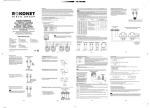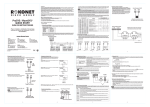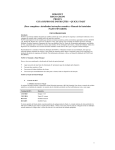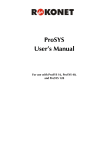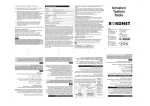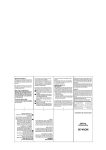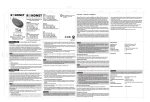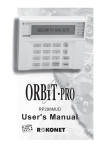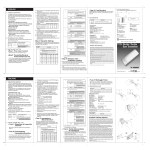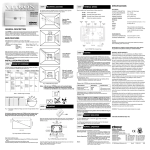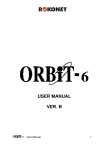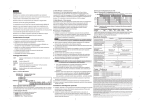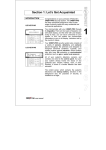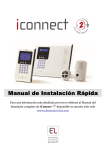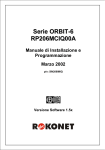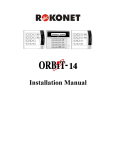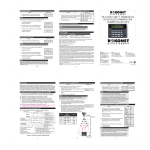Download quick start english
Transcript
Introduction ProSYS is a modular integrated system that combines access control, security protection, and home automation, with the advantage of controlling the whole system through one interface. ProSYS is available in three models that use the same accessories, but have different maximum capabilities (ProSYS 128, ProSYS 40, ProSYS 16) . Through its 4-wire BUS, it can support a variety of optional modules, including multiple Keypads, Zone Expanders, a Wireless Interface, supplemental Power Supplies, a Voice module, capabilities for Access Control, an X-10 Interface, Event Log, and Utility Outputs. All these devices communicate with the system by sending commands and data over the BUS, which originates at the Main Panel. R I S C O G R O U P ProSYS / WaveSYS* QUICK START INSTRUCTIONS GUIDE (For full comprehensive instructions refer to the ProSYS Installer Manual 5IN128IM) We recommend reading and fully understanding the ProSYS Installation manual and User’s manual before any installation of the system is carried out. The Quick Start Instructions guide is intended for those who have experience in installing Rokonet security panels. For additional information refer to the ProSYS Installer Manual (p/n 5IN128IM). STEP 1: Mounting the Main Panel Consideration in locating the fixing of the main panel should be given to: ● Dry place near an AC power supply (switched off). ● With a good earth connection. ● With access to the customer's phone lines. ● Access for the routing of cables for the system from detection devices. When connecting the Power Supply Module do NOT make any connection to the AUX (RED) terminal from the Main Panel. It is used for the outgoing BUS to supply voltage to other modules. The module supplies power to all modules and/or keypads located AFTER the point that it is connected to the BUS. Notes: In the ProSYS 16 and the ProSYS 40, there is only one BUS, which can be connected to the BUS 1 terminal block or to one of the two BUS 1 plugs (J1 and J5). In the ProSYS 128, there is also a BUS 2, which is separate from BUS 1. You can connect to the BUS 2 terminal block or to the BUS 2 plug (J8). In addition, if one of the BUSes is shorted or there is any kind of problem that interrupts the BUS data, the other one will continue to operate normally. 3. Wiring Auxiliary Devices The main panel has 2 aux terminals. Use the Auxiliary Power AUX (+) COM (-) terminals to power PIRs, glass-break detectors (4-wire types), smoke detectors, audio switches, photoelectric systems and/or any device that requires a 12V DC power supply. The total power from the AUX terminals should not exceed 600mA. If the auxiliary outputs are overloaded (exceed 600mA) and are shut down, you must disconnect all loads from the outputs for a period of at least 10 seconds before you reconnect any load to the auxiliary outputs. B: Defining Modules ID number Each accessory has its ID category number, which is defined by dipswitches. ID numbers are defined per category and the first module in each category is defined as ID=1. Before setting power on, define each module’s ID number by setting the dipswitches as follows: ID 01 02 03 04 05 06 07 08 09 10 11 12 13 14 15 16 STEP 2: Wiring the Main Panel 1. BUS Connection A: Wiring External Modules The set of four terminals on the left of the Main Panel represents the Expansion BUS. These support the connection of keypads and expansion modules. The connections are terminal-to-terminal with color-coded wires, as follows: BUS Terminal Description AUX RED +12V power COM BLK Black 0V common BUS YEL Yellow DATA BUS GRN Green DATA The parallel wiring system supports parallel connections from any point along the wiring. The maximum wire run permitted is 300 meters (1000 feet) for all legs of the BUS. To prevent a possible drop in voltage due to multiple keypads and long wire runs, use a quality 4-conductor cable with an appropriate gauge size. 1 OFF ON OFF ON OFF ON OFF ON OFF ON OFF ON OFF ON OFF ON Dipswitches 2 3 OFF OFF OFF OFF ON OFF ON OFF OFF ON OFF ON ON ON ON ON OFF OFF OFF OFF ON OFF ON OFF OFF ON OFF ON ON ON ON ON 4 OFF OFF OFF OFF OFF OFF OFF OFF ON ON ON ON ON ON ON ON Modules ID Range Category PROSYS MAIN PANEL AUX COM Auxiliary device as: PIR,Glass break detector , Audio switch ... ProSYS 16 ProSYS 40 ProSYS 128 Zone Expanders (include wireless) 1 1-4 1-8 Keypads 1-8 1-12 1-16 Output Modules 1-2 1-4 1-8 Supervised Power Supply 1-8 1-8 1-8 Access Control Modules 1-2 1-4 1-8 Memory Expansion ID=1 ID=1 (512 events) (512 or 999) Digital Key Readers 1-16 1-16 1-16 Voice Module 1 1 1 Wireless Key Buttons 1 1-4 1-4 PROSYS MAIN PANEL Z COM TYPICAL FIRE ZONE WIRING (Two 4 wire smoke detectors) UO AUX +IN +OUT +IN +OUT Control Panel Bus Connectors www.rokonet.com USA Rokonet Industries, Inc. Tel: +1-305-592-3820 Fax: +1-305-592-3825 Toll Free: 1-800-344-2025 e-mail: [email protected] ITALY Rokonet Electronics SRL Tel: +39-02-392-5354 Fax:: +39-02-392-5131 e-mail: [email protected] BRAZIL Rokonet Brasil Ltda. Tel: +55-21-2496.3544 Fax:: +55-21-2496.3547 e-mail:[email protected] 2. Zone Inputs Connection To connect a hardwired zone use a 4-conductor cable wiring. Connect each zone to the appropriate Zone (Z) terminal and its related COM terminal. Each pair of zones shares a COM terminal. It is recommended that you use an End-of-Line Resistor at the far end of each hardwired zone to prevent short-circuits (16 resistors are supplied). For a zone with a tamper switch, you can use a Double End-of-Line Resistor to save additional Main Panel connections BUS YEL GRN UK Rokonet U.K. Ltd. Tel: +44-1527-576-765 Fax: +44-1527-576-816 Free Phone: 0800-269881 e-mail: [email protected] DATA DATA DATA DATA 0V 0V BREAK +12V AT INPUT TO EACH X POWER SUPPLY (KEEP 0V COMMON) +12V NORMALLY CLOSED ZONE CONFIGURATION zone +12V NORMALLY OPEN ZONE CONFIGURATION zone com com AUX COM RED BLK BUS YEL GRN AUX COM RED BLK BUS YEL GRN AUX COM RED BLK Expansion Module Expansion Module Bus Connectors Bus Connectors 5IN128IMQ BUS YEL GRN Power Supply Bus Connectors AUX COM RED BLK zone END OF LINE ZONE (N.O CONTACT) com BUS YEL GRN Expansion Module Bus Connectors ALARM ALARM DETECTOR DETECTOR page 2 4. Bell Sounder Wiring The Bell/LS terminal determines the output for the bell or external sounder. When connecting the internal sounding device pay attention to the polarity. To avoid Bell Loop Trouble, if NO connection is made to an internal sounder, use a 2.2KΩ resistor in its place. It is important to position the BELL/LS Jumper (J3) correctly. The position varies depending on the type of internal sounder. A maximum of 900 mA may be drawn from this terminal. END OF LINE ZONE (N.C CONTACT) zone com 2.2 K * WaveSYS Installation & Programming Instructions in this document are equivalent to ProSYS 40. PROSYS MAIN PANEL BELL/LS + 7. Utility Output Wiring UO1: Relay output (3 Amps). Usually used for an external siren connection. Use the J10 jumper located on the main board to determine the UO1 (behaviour) as follows: LOUDSPEAKER (13.8 v, 900 mA MAX) ALARM DETECTOR ALARM DETECTOR 2.2 K EOL RESISTOR 2.2 K 2.2 K ALARM DETECTOR TAMPER page 4 ◆ 2. After a short delay the following display appears: To Install Press * 3. Press [*]. The keypad prompts you for the Installer code. depending on the ProSYS Model: 4. Enter the default Installer Code followed by ● ProSYS 128: [0][1][2][8] ● ProSYS 40: [0][1][4][0] ● ProSYS 16: [0][1][1][6] 5. The system enters the automatic accessories recognition process. Press 6. To exit Installer programming press “0” from the Installer’s main menu. Position the J2 default jumper on one pin to save data. PROSYS MAIN PANEL 5. Bell Tamper Wiring Connect the 230V AC to the mains fuse input terminal block (N,L). Fasten the AC cord to the metal box using adjustable clamps. Note: Be sure to connect the live wire of the AC power through the AC fuse. The size of the conductors must not be less than 0.75mm2 (18AWG). Single pin: If the J10 connector is placed only on 1 pin, the UO1 acts as a dry contact. 2.2 K EOL RESISTOR BELL TAMPER UO2-UO6: Transistor outputs (UO2 — 500 mA, UO3-UO6 70 mA). Connect the positive connection of the device to AUX (+) and the negative (-) connection to the UO's terminals. 6. Box Tamper Wiring Connect the box tamper to the BOX TMP and COM terminals on the Main Panel, as illustrated. BOX TMP COM Note: The Box Tamper input provides double protection, wall and box. PROSYS MAIN PANEL Connect the incoming telephone line to the Main Panel's LINE terminals. Connect any telephone on the premises to the SET terminals. SET To access the Installer Programming Menu from the regular operation mode: (J2 is on one pin) 1. From the regular (user) operation mode press: [*][7][1] 2. The keypad prompts you for the Installer code. for accessing the Installer menu. 3. Enter the Installer Code followed by ◆ Reset to default modes To restore the Main Panel to the manufacturer's defaults: 1. Disconnect all power from the Main Panel. 2. Position the J2 default jumper on both of the J2 pins. 3. Reconnect the power to the main and backup battery to the Main Panel. The keypad sounds a long beep and all of the LEDs flash once. After 20 seconds the following message is displayed: “To Install Press *” 4. On the Main Panel, reposition the J2 default jumper on one of the J2 pins (where it resides for safekeeping). 5. Remember that the Installer Code has been restored to the manufacturer's default setting. 315 mA 40 VA L N STEP 3: Installer Programming The ProSYS can be programmed from local or remote Upload/Download software or from the LCD Keypad used as an interface tool. The following keys are used in the programming procedure. For additional information refer to the Installer manual. Key 8. Telephone Line Connection 16.5 VAC Programming Mode Function Note: To enable the restore of the manufacturer's default, the system bit "Default Enable/Disable" (defined in quick key [1][7] in the main Installer menu) must be defined as Enable. Use this key to exit the current programming selection and move up to the next higher level in the programming hierarchy catalog. LINE Press either one of these keys to move back and forth through the programming level functions. These keys also change the position of the flashing cursor. When editing a selection, the cursor moves to the left or right respectively. T R TIP RING Use this key to toggle forward through the programming choices within a selection. Use this key to toggle backward through the programming BOX TAMPER (N.C) choices within a selection. Use this key to enter selected information into the system or to accept the current selection and access the TO TELEPHONE LINE page 5 page 6 to acknowledge each module. 7. ◆ FUSE A C Initial Setting 1. When defaulting the panel (position J2 on both pins and then power on the system) you enter the installer Programming menu and the Auto Install feature (Automatic Module recognition). The first display will be: ROKONET Please Wait... Connecting to ground must be performed according to the local National Electrical Code. 11.Main Power Connection COM ALRM -OUT CONTACT com zone 10. Ground Connection Connect the metal box and the door of the metal box to main earth (ground). Note: Negative (NEG): When the J10 connector is placed on NEG, the C terminal on UO1 supplies COM. BELL TMP -IN DOUBLE END OF LINE ZONE CONFIGURATION 9. Setting Jumpers Use the following table to position the jumpers located on the ProSYS main board Jumper Jumper Description Jumper Operation J2 Default jumper For regular operation position the default jumper over one of the J2 connector pins for safekeeping. To default the system position the jumper over the 2 pins J3 Bell/Loudspeaker Set this jumper according to the type of siren connected to the system (bell or loudspeaker) J4 SIG IN Connect to the voice module p/n RP200VC J6 Voice Connector This connector transmits signals from the Advanced Digital Voice module to the telephone line during remote communication, and is essential for normal operation of the Digital Voice module. J1, J5, J8 are used as quick BUS connectors. Use the 4 pin BUS plugs for easy connection of the BUS Adapter Cable (RP296EBA) or the Memory Transfer Card. BELL Connect the bell tamper to the BELL TMP and COM terminals on the Main Panel, as illustrated. ALRM -OUT CONTACT page 3 Positive (POS): When the J10 connector is placed on POS, the C terminal on UO1 supplies 13.8V. - -IN Zone Terminations 2.2 K ISRAEL Rokonet Electronics, Ltd. 14 Hachoma st. 75655 Rishon Letzion Tel: +972-3-961-6555 Fax: +972-3-961-6584 e-mail: [email protected] www.rokonet.com AUX COM RED BLK lower level of options in the programming hierarchy. page 7 page 8 INSTALLER PROGRAMMING MENUS [1] Quick Key [1][1] [1][1][1] [1][1][1][1] [1][1][1][2] [1][1][2] [1][1][2][1] [1][1][2][2] [1][1][3] [1][1][4] [1][1][5] [1][1][6] [1][1][6][1] [1][1][6][2] [1][1][7] [1][1][7][1] [1][1][7][2] [1][1][8] [1][1][9] [1][1][9][1] [1][1][9][2] [1][2] [1][2][ 01.. 34] SYSTEM Parameter Default System: Time Define Exit Entry Delay 1 Entry Delay 1 30 Exit Delay 1 45 Exit Entry Delay 2 Entry Delay 2 45 Exit Delay 2 60 Bell Time Out 04 Bell Delay 00 Switched Auxiliary Break 10 Wireless Module Times Jamming Time None Supervisory (S.V) Time 0 Zone Test Times Start Test HR:00;MIN:00 Zone Test Period 00 AC Off Delay 30 More Times Phone Line Cut Delay 04 Guard Delay 30 System: System Control Parameter Default Parameter 01) Quick Arm YES 13) Alarm Zone Expander Cut 02) Quick UO YES 14) Fire Temporal Alarm 03) Allow Bypass YES 15) Grand Master Code 04) Quick Bypass NO 16) Audible Jamming 05) False Code NO 17) Technical Tamper Trouble 06) Bell Squawk YES 18) Technical Reset 07) Bell 30/10 NO 19) Abort Alarm [1][3] [1][3][1] [1][3][2] [1][4] [1][4][1] [1][4][2] [1][4][3] [1][5] [1][5][0] [1][5][ 1..8] [1][6] 08) Alarm Phone Cut NO 09) 3 Minutes Bypass YES 10) Double Verification NO Fire Alarm 11) Audible Panic NO NO 12) Buzzer➔Bell System: Set Clock System Date System Time System: Windowing Window Start Window Stop Window Days System: Labels Global Partition 1 — Partition 8 System: Tamper Sound [1][7] [1][8] [1][8][1] [1][8][2] [1][9] System: Default Enable System: Service Information Service Name Service Phone System: System Version [2] Quick Key [2][1] [2][2] [2][3] Range 0-255 sec 0-255 sec 0-255 sec 0-255 sec 01-90 min 00-90 min 01-90 sec ZONES Parameter Options Zones: One By One Zones: Partitions Zones: Zone Type [2][3][ZZ] + [DISARM] +[00-22] 00) Not Used 01) Exit Entry 1 02) Exit Entry 2 03) Exit (Open)/Entry 04) Entry Follower 05) Instant 06) Interior + Exit Entry 1 07) Interior + Exit Entry 2 08) Interior + Exit (Open)/Entry None, 10,20,30 sec 0-7 hours [2][4] Zones: Zone Sound [2][4][ZZ] + [DISARM] +[1-6] 00-24 Hours, 00-59 Min 00-24 Hours 0-255 Min [2][5] Zones: Zone Termination [2][5][ZZ] + [DISARM] +[1-4] Zones: Loop Response [2][6][ZZ] + [DISARM] +[1-12] [2][6] 01-20 Min 01-99 Min Default Parameter NO 25) Engineer Tamper NO NO NO NO NO NO 20) Summer/Winter Clock NO 21) Forced Keyswitch Arming YES 22) Pager NO 23) Arm Pre Warning 24) Low Battery Arm Default NO 26) Blank Display 27) 24 Hour Bypass 28) IMQ Install 29) Grand Master Authority/Partition 30) Double Code 31) Disarm Stop Follow Me 32) Global Follower 33) Area 34) Disable Keypad when Auto Disarm exist YES YES JAN 01 2000 (SAT) 00:00 DD MM YYYY (DAY) HH:MM HR:00;MIN:00 HR:00;MIN:00 All 00-24 Hours, 00-59 Min 00-24 Hours, 00-59 Min SUN(Y/N)-SAT(Y/N) Rokonet Partition 1 — Partition 8 Bell/Arm Buzzer/Disarm 12 Characters 12 Characters 1) Silent 3) Buzzer Only 5) Bell/Arm NO NO NO YES NO YES YES NO NO 09) Interior + Entry Follower 10) Interior + Instant 11) Utility Output Trigger 12) Day Zone 13) 24 Hours 14) Fire 15) Panic 16) Special Emergency 17) Pulsed Keyswitch 2.The loop response times defined in locations 5 to 12 can be assigned only to zones 1 to 8 on the Main Panel or to zones located on the zone expander RP128EZ8F00A. 1) None 2) Ordered 3) Not Ordered Zones: Cross Zones [2][8] [2][9] [2][9][1] [2][9][2] [2][9][3] [2][9][4] [2][9][5] [2][9][6] [2][9][7] [2][9][8] [2][9][9] [2][0] [2][0][1] [2][0][2] Zones: Zone Labels Zones: Maintenance Copy to a Zone Delete a Zone Add/Copy Partition Delete a Partition Wireless Module Calibration Wireless Zone Allocation Wireless Communication Test Zone Self Test Soak Test Zones: Miscellaneous Forced Arming Pulsed Count [3][1] Utility Output: Follow System Event 01) Bell Follow 02) No Telephone Line 03) Communication Failure 04) Trouble Follow 05) Ground Pulse 06) Low Battery 07) Ac Loss Follow 08) Sensors Test 09) Voice Module 10) Battery Test 11) Bell Burglary 12) Scheduler 13) Digital Reader Communication 14) Switched Auxiliary Utility Output: Follow Partition Event 01) Ready Follow 02) Alarm follow 03) Arm Follow 04) Burglary Follow 05) Fire Follow 06) Panic Follow 07) Special Emergency Follow 08) Duress Follow 09) Buzzer Follow 10) Chime Follow 11) Exit/Entry Follow 12) Fire Trouble 13) Day zone Trouble 14) General Trouble [3][2] [3][3] Utility Output: Follow Zone [3][4] [4] Quick Key [4][1] CODE Parameter Code Maintenance: Authority Level [4][2] Code Maintenance: Partition Code Maintenance: Grand Master Code Maintenance: Installer Code Maintenance: Sub Installer Code Maintenance: Code Length [4][4] [4][5] [4][6] [5] Quick Key [5][1] [5][1][1] [5][1][2] [5][1][3] [5][1][4] [5][2] [5][3] [5][3][1] [5][3][2] [5][3][3] 2) Bell Only 4) Bell +Buzzer 6) Buzzer/Disarm 16 Characters 16 Characters page 9 Options 15) Stay Follow 16) Tamper Follow 17) Disarm Follow 18) Bell Follow 19) Bell Stay Off 20) Zone Bypass 01) Zone Follow 03) Arm Follow 02) Alarm Follow 04) Disarm Follow Note: Each utility output can be activated by a group of up to five zones. [5][4] [5][4][1] [5][4][2] [5][4][3] [5][5] [5][5] [01..14] [5][6] [5][6][1] [5][6][2] [5][6][3] [5][6][4] Dialer: Access and ID Access Code ID Code MS Lock Dialer: Controls Parameter 01 MS Enable 02 Follow Me Enable 03 Upload/Download Enable 04 Call Delay 05 Dial Tone Wait 06 Call Save 07 User Initiated Call Dialer: Parameters Monitoring Station Retries Follow Me Retries Ring to Upload/Download Dial Tone Time [5][6][5] Redial Wait 30 [5][6][6] Dialing Method DTMF [5][6][7] Pulse Duty Cycle 61/39 [5][6][8] [5][7] [5][7][1] Swinger Shutdown Limit Dialer: Report Split Monitoring Station Arm/Disarm 00 [5][7][2] Monitoring Station Urgent 1s1 Backup 2nd [5][7][3] Monitoring Station Non Urgent 1s1 Backup 2nd [5][7][4] [5][7][4] [1..8][1] [5][7][4] [1..8][2] Follow Me Phone Partition Phone Event Event 01) Intruder 02) Fire 03) Emergency 04) Panic 05) Tamper 06) Remote Programming 07) AC Off 08) Duress 09) Arm 5678 0001 000000 Default YES YES YES NO YES No YES Parameter 08 Call Back Upload/Download 09 Auto Batch 10 Answering Machine Override 11 UL Installation 12 Show Kiss Off 13 Show Handshake 14 Audible Kissoff 08 03 12 6 Options Grand Master Manager User Arm Only Cleaner Utility Output Activation 1s1 Backup 2nd User Unbypass Guard 1) 4 Digits 2) 6 Digits DIALER Parameter Default Dialer: Telephone Numbers MS Phone 1 MS Phone 2 MS Phone 3 Remote Upload/Download Phone Dialer: Customer Account Number Dialer: Communication Format Format for MS Phone 1 Format for MS Phone 2 Format for MS Phone 3 page 10 Range 32 characters Default YES YES YES YES NO NO NO YES NO page 11 Default YES NO YES NO NO NO NO 01-15 01-15 01-15 1) 6 seconds 2) 9 seconds 1) 30 sec 2) 60 sec 1) DTMF 2) Pulse @ 20 BPS 3) Pulse @ 10 BPS 1) 67/33 2) 61/39 00-15 Utility Output: Follow Code [4][3] Yes ProSYS Security System UTILITY OUTPUT Parameter Utility Output: Follow Nothing 18) Exit Termination 19) Latched Keyswitch 20) Entry Follower + Stay 21) Keyswitch Delay 22) Latched Keyswitch Delay 1) Silent 4) Bell + Buzzer 2) Bell Only 5) Door Chime 3) Buzzer Only 6) Bell/Arm Buzzer/Disarm 1) Normally Close 3) Double End Of Line 2) End Of Line 4) Normally Open 1) Normal (400 ms) 05) 0.5 Hour 09) 2.5 Hours 2) Slow( 1 sec) 06) 1 Hour 10) 3 Hours 3) Fast (10 ms) 07) 1.5 Hours 11) 3.5 Hours 4) Very Fast (1 ms) 08) 2 Hours 12) 4 Hours Note: 1.The loop response 1 ms (option 4) is usually used for shutters or other devices that require very quick responses. This loop response time can be defined only for zones located on the zone expander RP128EZ8F00A. [2][7] [3] Quick Key [3][0] 1) Do not call 2) Call 1s1 3) Call 2nd 4) Call 3rd 5) Call All 6) 1s1 Backup 2nd 1) Do not call 2) Call 1s1 3) Call 2nd 4) Call 3rd 5) Call All 6) 1s1 Backup 2nd 1) Do not call 2) Call 1s1 3) Call 2nd 4) Call 3rd 5) Call All 6) 1s1 Backup 2nd Event 10) Disarm 11) Bypass 12) Wireless lost 13) Wireless Low Battery 14) Bell Trouble 15) False Code 16) Low Battery 17) Wireless Jamming 18) BUS Trouble Default NO NO NO NO NO NO NO NO NO page 12 ) [5][7][4][ 1-8][3] [5][8] [5][8][1..3] Phone Restore Events Event 01) Intruder 02) Tamper 03) AC Off 04) Wireless lost 05) Wireless Low Battery Dialer: Alarm Restore Alarm Restore [5][9] [5][9][1] [5][9][2] [5][0] [5][0][1] [5][0][2] [5][0][3] Dialer: Periodic test Monitoring Station Test Upload Download Test Dialer: Auto Codes Contact ID SIA Delete All [6] Quick Key [6][1] [6][1][1][1..4] [6][1][2][1..4] [6][2][1..9] REPORT CODES Parameter Report Codes: Emergency Key Emergency Key Alarm Emergency Key Alarm Restore Report Codes: Zones Default YES NO NO NO NO On Bell Time out [6][4] [6][4][1][1..0] [6][4][2][1..0] [6][5] [6][5][1][1..4] [6][5][2][1..4] [6][6] [6][6][1..7] Report Codes: Accessory Tamper Report Codes: Main Trouble Main Trouble Main Trouble Restore Report Codes: Power Supply Module Trouble Trouble Condition Trouble Condition Restore Report Codes: Arm Codes Arm Codes Default NO NO NO NO 1) On Bell Time put 2) Follow Zone 3) At Disarm [6][8] [6][8][1..0] [6][9] [6][0] [6][0][1..4] [7] Quick Key [7][1] [7][1][1..9] Report Codes: Disarm Codes Disarm Codes Report Codes: Miscellaneous Miscellaneous Report Codes: Special communication Report Codes: Accessory Code Accessory Code 1) 2) 1) 2) 1) 2) 3) 3) 4) 3) 4) 5) 6) 7) 8) 9) 1) 2) 3) 4) Auxiliary Emergency Panic Auxiliary Emergency Panic Alarm Alarm Restore Day zone Trouble/ Wireless Zone Supervision Day zone Trouble/ Wireless Zone Supervision Restore Keypad Utility Output Power Supply Event Logger [7][2] [7][3] [7][4] [7][5] Accessories: Verify Module Accessories: Bus Test Accessories: Bus Scan Accessories: Auto Settings [8] [8][1] 5) Wireless Button Accessory 6) Wireless Zone Module 7) Advanced Voice Module [8][2] MISCELLANEOUS Miscellaneous: Wireless Button Parameters Miscellaneous: Wireless Button Allocation 1) 2) 3) 4) 5) 1) 2) 3) 4) 5) Low Battery Bell Phone AC Loss Aux Fail Low Battery Bell Phone AC Loss Aux Fail 6) 7) 8) 9) 0) 6) 7) 8) 9) 0) [9] Quick Key [9][1] [9][1][1] [9][1][2] [9][1][2][1] [9][1][2][2] [9][1][2][3] [9][1][3] [9][1][4] [9][1][4][1] [9][1][4][2] [9][1][5] [9][2] [9][3] [9][3][1] Clock Not Set BUS Fail False Code Bell Tamper Box Tamper Clock Not Set BUS Fail False Code Bell Tamper Box Tamper 1) 2) 1) 2) Low Battery Bell Low Battery Bell 3) 4) 3) 4) 1) 2) 3) 4) User Arm Keyswitch Arm Auto Armed Remote Arm 5) Quick Arm 6) Force Arm 7) Wireless Button Arm page 13 AC Loss AUX Fail AC Loss AUX Fail [0] ACCESS CONTROL Parameter Door Define Partitions Door Time Setting Open Delay Door Force Delay Door Alarm Delay Door Fire Settings Door Input Settings Door contact Request to Exit Button Door Label Card Code Position Special Code Arm Code Quick Arm Code 4) Remote Disarm 5) Wireless Button Disarm 1) 2) 3) 4) 5) 6) System Reset 7) Abort Alarm 8) Self Test O.K 9) Self Test Failure 10) Cancel Report Enter Programming Exit Programming Periodic MS Test Periodic UD Test Call Back Request 3) Wireless Button Battery 4) Printer Module Wiring information: Use the following tables for selecting the correct wire thickness to minimize the power loss and ensure reliable system operation. Take into account the installations current requirements and the wiring distances involved Wire Gauge 24 AWG 22 AWG 20 AWG 19 AWG Options 1) Keypad 2) Zone Expander 3) Utility Output 4) Power Supply 5) Event Log 6) Wireless Button 7) Printer Module 8) Access Control 91) Digital Key Reader 92) Advanced Digital Voice Module (0.5 mm / 0.02inch) (0.64mm / 0.025inch) (0.8 mm / 0.031inch) (0.9 mm / 0.035inch) Max Combined Length (BUS) from Panel to Expansion module 150 meters 492 feet 200 meters 656 feet 333 meters 1092 feet 400 meters 1312 feet Desired Wire Gauge for Detectors Wiring Distances Max Current (mA) ACCESSORIES Parameter Accessories: Add/Delete Module Add/Delete Module Fire Duress Fire Duress Bypass Zone Tamper Zone Tamper Restore Low Battery Low Battery Restore 1) User Disarm 2) Keyswitch Disarm 3) Auto Disarm 1) Wireless Zone Expander 2) Wireless Button Module Options 4) [6][3][1..7] Event 06) Bell Trouble 07) Low Battery 08) Wireless Jamming 09) BUS Trouble [6][7] [6][7][1..5] 20mA 30mA 40mA 50mA 60mA 70mA 80mA 90mA 100mA 18 AWG (1.00mm / 0.04inch) 19 AWG (0.9 mm / 0.035inch) Max Run Meters Feet 1195 3920 793 2600 597 1960 478 1568 296 1300 341 1120 299 980 264 867 239 784 Max Run Meters Feet 945 3100 628 2060 472 1550 378 1240 314 1030 270 886 237 775 209 687 189 620 20 AWG 22 AWG (0.8 mm / 0.031inch) (0.64 mm/ 0.025inch) Max Run Meters Feet 750 2460 500 1640 375 1230 300 984 250 820 214 703 187 615 166 547 123 492 Max Run Meters Feet 472 1550 314 1030 236 775 189 620 157 515 135 443 118 388 105 343 94 310 24 AWG (0.5 mm / 0.02inch) Max Run Meters Feet 296 970 197 646 148 485 118 388 98 323 84 277 74 243 66 215 59 194 Main Panel Technical Data: Default Range 4 NO 10 Open 1-99 sec YES/NO 1-99 sec Open/Close N.O N.O N.O/N.C N.O/N.C 00 00-37 99 98 00-99 00-99 Input Power Current Consumption Rechargeable Standby Battery Power Outputs: Auxiliary Power Bell/LS (External) Sounder Output 16.5 Volts AC @ 40 Volt-Amps (VA) (via integral transformer) 60 mA, typical / 70 mA, maximum 12 Volts up to 17 Amp-Hours (AH), typical Programmable Voltage (Utility) Output UO1: Relay (programmable output) (3 Amps) UO2: 500 mA transistor UO3-UO6: Open Collector, 70 mA, maximum 375 mm x 330 mm x 98 mm 200 mm x 115 mm x 65 mm F3 3.0 A Battery Power AUX Automatic fuse BELL Automatic fuse Cabinet Dimensions Main Board Dimensions Fuses 12 Volts DC @ 600 mA, maximum (from all AUX terminals) 12 Volts DC @ 900 mA, maximum Technical Data of Expansion Modules: Module 8 LED Keypad 16 LED Keypad LCD Keypad Proximity LCD Keypad 8 zone expansion module 16 zone expansion module 8,16 wireless zone expansion module 4 relay output expansion module 8 transistor output expansion module Power Supply Expansion Module Current Consumption 32 mA, typical / 72 mA maximum 32 mA, typical / 72 mA maximum 75 mA maximum 100 mA maximum 25 mA, typical / 30 mA, maximum 27 mA, typical / 34 mA, maximum 12 mA, typical / 15 mA, maximum 25 mA, typical / 140 mA, maximum 25 mA, typical / 30 mA, maximum Additional Information Frequency: 868.6-868.7 MHz (narrowband operation in EU) Receiving Range: 200 m (Key fob) - 400 m (detectors) Contacts: 4 Form C (SPDT) Relays. Contact rating: 3 A / 24V DC Contacts: Open Collector, Active Pull-Down, 70 mA maximum Input Power: Rechargeable Standby Battery: Power Outputs: Fuses: Event Log Expansion Module Printer Module X-10 Transmitter Module Access Control Module Voice Module Electronic Key Reader Advance Digital Voice Module Voice Message Unit 25 mA, typical / X 30 mA, maximum 7 mA, typical / 10 mA, maximum 25 mA, typical / 29 mA, maximum 100 mA maximum Input power Readers Consumption Relay 6 mA, typical/ 26 mA maximum 11 mA, typical / 17 mA maximum 38 mA, typical / Audio Signal 57 mA maximum 9 mA (standby) / Audio Signal 60 mA (active speaking normal volume) / 130 mA (active speaking full volume) 12 Volts up to 17 Amp-Hours (AH), typical Auxiliary power: 12 Volts DC @ 600 mA, maximum Bell/LS (External) Sounder Output: 12 Volts DC @ 900 mA, maximum F1: Battery power 3.0 A F2: Auxiliary power 2.0 A F3: Bell/loudspeaker power 1.0 A 13.8V DC + 10% 5V / 150 mA maximum 24V DC / 1 A maximum Max = 5V pp / Max = 2V V in max = 2.5V pp / V out max = 4V pp RTTE COMPLIANCE STATEMENT Hereby, Rokonet Electronics Ltd, declares that this control panel (RP128MC0000A, RP140MC0000A, RP116MC0000A), with wired accessories (including cables) and wireless accessories, is in compliance with the essential requirements and other relevant provisions of Directive 1999/5/EC. EXIT PROGRAMMING page 14 16.5 Volts AC @ 40 VA (via transformer) page 15 page 16


